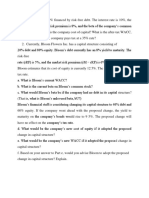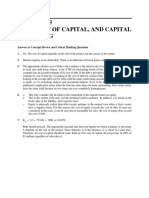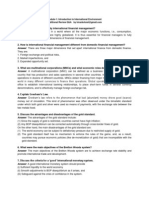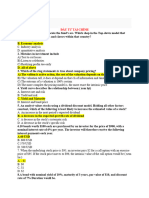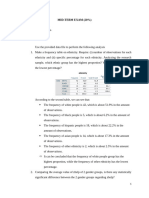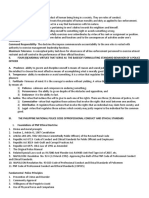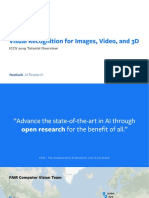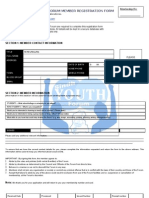0 ratings0% found this document useful (0 votes)
559 viewsCost of Capital-Qns
Cost of Capital-Qns
Uploaded by
Harmeet Singh AroraThe document discusses concepts related to cost of capital, including the cost of equity, cost of debt, weighted average cost of capital (WACC), and beta. It provides examples of calculating these measures for various companies. For a company called Kruspa expanding into China, it estimates the project's cost of equity and debt, WACC, asset and equity betas, and the sensitivity of the project's net present value to different assumptions about cost of equity.
Copyright:
© All Rights Reserved
Available Formats
Download as DOCX, PDF, TXT or read online from Scribd
Cost of Capital-Qns
Cost of Capital-Qns
Uploaded by
Harmeet Singh Arora0 ratings0% found this document useful (0 votes)
559 views6 pagesThe document discusses concepts related to cost of capital, including the cost of equity, cost of debt, weighted average cost of capital (WACC), and beta. It provides examples of calculating these measures for various companies. For a company called Kruspa expanding into China, it estimates the project's cost of equity and debt, WACC, asset and equity betas, and the sensitivity of the project's net present value to different assumptions about cost of equity.
Original Description:
Cost Of Capital
Copyright
© © All Rights Reserved
Available Formats
DOCX, PDF, TXT or read online from Scribd
Share this document
Did you find this document useful?
Is this content inappropriate?
The document discusses concepts related to cost of capital, including the cost of equity, cost of debt, weighted average cost of capital (WACC), and beta. It provides examples of calculating these measures for various companies. For a company called Kruspa expanding into China, it estimates the project's cost of equity and debt, WACC, asset and equity betas, and the sensitivity of the project's net present value to different assumptions about cost of equity.
Copyright:
© All Rights Reserved
Available Formats
Download as DOCX, PDF, TXT or read online from Scribd
Download as docx, pdf, or txt
0 ratings0% found this document useful (0 votes)
559 views6 pagesCost of Capital-Qns
Cost of Capital-Qns
Uploaded by
Harmeet Singh AroraThe document discusses concepts related to cost of capital, including the cost of equity, cost of debt, weighted average cost of capital (WACC), and beta. It provides examples of calculating these measures for various companies. For a company called Kruspa expanding into China, it estimates the project's cost of equity and debt, WACC, asset and equity betas, and the sensitivity of the project's net present value to different assumptions about cost of equity.
Copyright:
© All Rights Reserved
Available Formats
Download as DOCX, PDF, TXT or read online from Scribd
Download as docx, pdf, or txt
You are on page 1of 6
Chapter_6: Cost of Capital
1. The cost of equity is equal to the:
A. expected market return.
B. rate of return required by stockholders.
C. cost of retained earnings plus dividends.
2. Which of the following statements is correct?
A. The appropriate tax rate to use in the adjustment of the before-tax cost of debt to determine the after-tax cost of debt is
the average tax rate because interest is deductible against the companys entire taxable income.
B. For a given company, the after-tax cost of debt is generally less than both the cost of preferred equity and the cost of
common equity.
C. For a given company, the investment opportunity schedule is upward sloping because as a company invests more in
capital projects, the returns from investing increase.
3. Using the dividend discount model, what is the cost of equity capital for Zeller Mining if the company will pay a
dividend of C$2.30 next year, has a payout ratio of 30 percent, a return on equity (ROE) of 15 percent, and a stock price
of C$45?
A. 9.61 percent.
B. 10.50 percent.
C. 15.61 percent.
4. Dot.Com has determined that it could issue $1,000 face value bonds with an 8 percent coupon paid semi-annually and
a five-year maturity at $900 per bond. If Dot.Coms marginal tax rate is 38 percent, its after-tax cost of debt is closest to:
A. 6.2 percent.
B. 6.4 percent.
C. 6.6 percent.
5. The cost of debt can be determined using the yield-to-maturity and the bond rating approaches. If the bond rating
approach is used, the:
A. coupon is the yield.
B. yield is based on the interest coverage ratio.
C. company is rated and the rating can be used to assess the credit default spread of the companys debt.
6. Morgan Insurance Ltd. issued a fixed-rate perpetual preferred stock three years ago and placed it privately with
institutional investors. The stock was issued at $25 per share with a $1.75 dividend. If the company were to issue
preferred stock today, the yield would be 6.5 percent. The stocks current value is:
A. $25.00.
B. $26.92.
C. $37.31.
7. A financial analyst at Buckco Ltd. wants to compute the companys weighted average cost of capital (WACC) using
the dividend discount model. The analyst has gathered the following data:
Before-tax cost of new debt 8 percent
Tax rate 40 percent
Target debt-to-equity ratio 0.8033
Stock price $30
Next years dividend $1.50
Estimated growth rate 7 percent
Buckcos WACC is closest to:
A. 8 percent.
B. 9 percent.
C. 12 percent.
8. The Gearing Company has an after-tax cost of debt capital of 4 percent, a cost of preferred stock of 8 percent, a cost of
equity capital of 10 percent, and a weighted average cost of capital of 7 percent. Gearing intends to maintain its current
capital structure as it raises additional capital. In making its capital-budgeting decisions for the average-risk project, the
relevant cost of capital is:
A. 4 percent.
B. 7 percent.
C. 8 percent.
9. Fran McClure of Alba Advisers is estimating the cost of capital of Frontier Corporation as part of her valuation
analysis of Frontier. McClure will be using this estimate, along with projected cash flows from Frontiers new projects,
to estimate the effect of these new projects on the value of Frontier. McClure has gathered the following information on
Frontier Corporation:
Current Year ($) Forecasted for Next Year ($)
Book value of debt 50 50
Market value of debt 62 63
Book value of shareholders equity 55 58
Market value of shareholders equity 210 220
The weights that McClure should apply in estimating Frontiers cost of capital for debt and equity are, respectively:
A. wd = 0.200; we = 0.800.
B. wd = 0.185; we = 0.815.
C. wd = 0.223; we = 0.777.
10. Wang Securities had a long-term stable debt-to-equity ratio of 0.65. Recent bank borrowing for expansion into South
America raised the ratio to 0.75. The increased leverage has what effect on the asset beta and equity beta of the
company?
A. The asset beta and the equity beta will both rise.
B. The asset beta will remain the same and the equity beta will rise.
C. The asset beta will remain the same and the equity beta will decline.
11. Brandon Wiene is a financial analyst covering the beverage industry. He is evaluating the impact of DEF Beverages
new product line of flavored waters. DEF currently has a debt-to-equity ratio of 0.6. The new product line would be
financed with $50 million of debt and $100 million of equity. In estimating the valuation impact of this new product line
on DEFs value, Wiene has estimated the equity beta and asset beta of comparable companies. In calculating the equity
beta for the product line, Wiene is intending to use DEFs existing capital structure when converting the asset beta into a
project beta. Which of the following statements is correct?
A. Using DEFs debt-to-equity ratio of 0.6 is appropriate in calculating the new product lines equity beta.
B. Using DEFs debt-to-equity ratio of 0.6 is not appropriate, but rather the debt-to-equity ratio of the new product,
0.5, is appropriate to use in calculating the new product lines equity beta.
C. Wiene should use the new debt-to-equity ratio of DEF that would result from the additional $50 million debt
and $100 million equity in calculating the new product lines equity beta.
12. Trumpit Resorts Company currently has 1.2 million common shares of stock outstanding and the stock has a beta of
2.2. It also has $10 million face value of bonds that have five years remaining to maturity and 8 percent coupon with
semi-annual payments, and are priced to yield 13.65 percent. If Trumpit issues up to $2.5 million of new bonds, the
bonds will be priced at par and have a yield of 13.65 percent; if it issues bonds beyond $2.5 million, the expected yield
on the entire issuance will be 16 percent. Trumpit has learned that it can issue new common stock at $10 a share. The
current risk-free rate of interest is 3 percent and the expected market return is 10 percent. Trumpits marginal tax rate is
30 percent. If Trumpit raises $7.5 million of new capital while maintaining the same debt-to-equity ratio, its weighted
average cost of capital is closest to:
A. 14.5 percent.
B. 15.5 percent.
C. 16.5 percent.
The following information relates to Questions 1318
Jurgen Knudsen has been hired to provide industry expertise to Henrik Sandell, CFA, an analyst for a pension plan
managing a global large-cap fund internally. Sandell is concerned about one of the funds larger holdings, auto parts
manufacturer Kruspa AB. Kruspa currently operates in 80 countries, with the previous years global revenues at 5.6
billion. Recently, Kruspas CFO announced plans for expansion into China. Sandell worries that this expansion will
change the companys risk profile and wonders if he should recommend a sale of the position.
Sandell provides Knudsen with the basic information. Kruspas global annual free cash flow to the firm is 500 million
and earnings are 400 million. Sandell estimates that cash flow will level off at a 2 percent rate of growth. Sandell also
estimates that Kruspas after-tax free cash flow to the firm on the China project for next three years is, respectively, 48
million, 52 million, and 54.4 million. Kruspa recently announced a dividend of 4.00 per share of stock. For the initial
analysis, Sandell requests that Knudsen ignore possible currency fluctuations. He expects the Chinese plant to sell only to
customers within China for the first three years. Knudsen is asked to evaluate Kruspas planned financing of the required
100 million with a 80 public offering of 10-year debt in Sweden and the remainder with an equity offering.
Additional information:
Equity risk premium, Sweden 4.82 percent
Risk-free rate of interest, Sweden 4.25 percent
Industry debt-to-equity ratio 0.3
Market value of Kruspas debt 900 million
Market value of Kruspas equity 2.4 billion
Kruspas equity beta 1.3
Kruspas before-tax cost of debt 9.25 percent
China credit A2 country risk premium 1.88 percent
Corporate tax rate 37.5 percent
Interest payments each year Level
13. Using the capital asset pricing model, Kruspas cost of equity capital for its typical project is closest to:
A. 7.62 percent.
B. 10.52 percent.
C. 12.40 percent.
14. Sandell is interested in the weighted average cost of capital of Kruspa AB prior to its investing in the China project.
This weighted average cost of capital (WACC) is closest to:
A. 7.65 percent.
B. 9.23 percent.
C. 10.17 percent.
5. In his estimation of the projects cost of capital, Sandell would like to use the asset beta of Kruspa as a base in his
calculations. The estimated asset beta of Kruspa prior to the China project is closest to:
A. 1.053.
B. 1.110.
C. 1.327.
16. Sandell is performing a sensitivity analysis of the effect of the new project on the companys cost of capital. If the
China project has the same asset risk as Kruspa, the estimated project beta for the China project, if it is financed 80
percent with debt, is closest to:
A. 1.300.
B. 2.635.
C. 3.686.
17. As part of the sensitivity analysis of the effect of the new project on the companys cost of capital, Sandell is
estimating the cost of equity of the China project considering that the China project requires a country equity premium to
capture the risk of the project. The cost of equity for the project in this case is closest to:
A. 10.52 percent.
B. 19.91 percent.
C. 28.95 percent.
18. In his report, Sandell would like to discuss the sensitivity of the projects net present value to the estimation of the
cost of equity. The China projects net present value calculated using the equity beta without and with the country risk
premium are, respectively:
A. 26 million and 24 million.
B. 28 million and 25 million.
C. 30 million and 27 million.
The following information relates to Questions 1922
Boris Duarte, CFA, covers initial public offerings for Zellweger Analytics, an independent research firm specializing in
global small-cap equities. He has been asked to evaluate the upcoming new issue of TagOn, a U.S.-based business
intelligence software company. The industry has grown at 26 percent per year for the previous three years. Large
companies dominate the market, but sizable pure-play companies such as Relevant, Ltd., ABJ, Inc., and Opus Software
Pvt. Ltd also compete. Each of these competitors is domiciled in a different country, but they all have shares of stock that
trade on the U.S. NASDAQ. The debt ratio of the industry has risen slightly in recent years.
Company Sales in
Millions
($)
Market Value
Equity in
Millions ($)
Market Value
Debt in
Millions ($)
Equity
Beta
Tax Rate Share Price
($)
Relevant Ltd. 752 3800 0.0 1.702 23% 42
ABJ, Inc 843 2150 6.5 2.800 23% 24
Opus Software Pvt. Ltd 211 972 13.0 3.400 23% 13
Duarte uses the information from the preliminary prospectus for TagOns initial offering. The company intends to issue 1
million new shares. In his conversation with the investment bankers for the deal, he concludes the offering price will be
between $7 and $12. The current capital structure of TagOn consists of a $2.4 million five-year non-callable bond issue
and 1 million common shares. Other information that Duarte has gathered:
Currently outstanding bonds : $2.4 million five-year bonds, coupon of 12.5 percent, with
a market value of $2.156 million
Risk-free rate of interes 5.25%
Estimated equity risk premium 7%
Tax rate 23%
19. The asset betas for Relevant, ABJ, and Opus, respectively, are:
A. 1.70, 2.52, and 2.73.
B. 1.70, 2.79, and 3.37.
C. 1.70, 2.81, and 3.44.
20. The average asset beta for the pure players in this industry, Relevant, ABJ, and Opus, weighted by market value is
closest to:
A. 1.67.
B. 1.97.
C. 2.27.
21. Using the capital asset pricing model, the cost of equity capital for a company in this industry with a debt-to-equity
ratio of 0.01, asset beta of 2.27, and a marginal tax rate of 23 percent is closest to:
A. 17 percent.
B. 21 percent. C.
24 percent.
22. The marginal cost of capital for TagOn, based on an average asset beta of 2.27 for the industry and assuming that new
stock can be issued at $8 per share, is closest to:
A. 20.5 percent.
B. 21.0 percent.
C. 21.5 percent.
23. Two years ago, a company issued $20 million in long-term bonds at par value with a coupon rate of 9 percent. The
company has decided to issue an additional $20 million in bonds and expects the new issue to be priced at par value with
a coupon rate of 7 percent. The company has no other debt outstanding and has a tax rate of 40 percent. To compute the
companys weighted average cost of capital, the appropriate after-tax cost of debt is closest to:
A. 4.2%.
B. 4.8%.
C. 5.4%.
24. An analyst gathered the following information about a company and the market:
Current market price per share of common stock $28.00
Most recent dividend per share paid on common stock (D0) $2.00
Expected dividend payout rate 40%
Expected return on equity (ROE) 15%
Beta for the common stock 1.3
Expected rate of return on the market portfolio 13%
Risk-free rate of return 4%
Using the discounted cash flow (DCF) approach, the cost of retained earnings for the company is closest to:
A. 15.7%.
B. 16.1%.
C. 16.8%.
25. An analyst gathered the following information about a company and the market:
Current market price per share of common stock $28.00
Most recent dividend per share paid on common stock (D0) $2.00
Expected dividend payout rate 40%
Expected return on equity (ROE) 15%
Beta for the common stock 1.3
Expected rate of return on the market portfolio 13%
Risk-free rate of return 4%
Using the Capital Asset Pricing Model (CAPM) approach, the cost of retained earnings for the company is closest to:
A. 13.6%.
B. 15.7%.
C. 16.1%.
26. An analyst gathered the following information about a private company and its publicly traded competitor:
Comparable Companies Tax Rate (%) Debt/Equity Equity Beta
Private company 30.0 1.00 N.A.
Public company 35.0 0.90 1.75
Using the pure-play method, the estimated equity beta for the private company is closest to:
A. 1.029.
B. 1.104.
C. 1.877.
27. An analyst gathered the following information about the capital markets in the U.S. and in Paragon, a developing
country.
Selected Market Information (%)
Yield on U.S. 10-year Treasury bond 4.5
Yield on Paragon 10-year government bond 10.5
Annualized standard deviation of Paragon stock index 35.0
Annualized standard deviation of Paragon dollar- denominated government bond 25.0
Based on the analysts data, the estimated country equity premium for Paragon is closest to:
A. 4.29%.
B. 6.00%.
C. 8.40%.
You might also like
- Maintenance & Reliability BOK - 2020Document149 pagesMaintenance & Reliability BOK - 2020Amr Kamal97% (32)
- FG2233Document11 pagesFG2233Hassan Sheikh0% (1)
- (CFA Institute Investment Series) Wendy L. Pirie - Derivatives-Wiley (2017) AbstractDocument3 pages(CFA Institute Investment Series) Wendy L. Pirie - Derivatives-Wiley (2017) AbstracttalhaNo ratings yet
- ADM 3351-Final With SolutionsDocument14 pagesADM 3351-Final With SolutionsGraeme RalphNo ratings yet
- CAMELS and PEARLS Applied To Financial Management of Commercial Bank in VietnamDocument44 pagesCAMELS and PEARLS Applied To Financial Management of Commercial Bank in VietnamDan LinhNo ratings yet
- Chapter05 TestbankDocument408 pagesChapter05 TestbankDuy ThứcNo ratings yet
- Corporate Finance ExercisesDocument14 pagesCorporate Finance ExercisesMatteoNebiolo100% (2)
- Financial Market and InstitutionDocument5 pagesFinancial Market and InstitutionMd MohimanNo ratings yet
- Optimal Risky Portfolios Chapter 7 PracticeDocument2 pagesOptimal Risky Portfolios Chapter 7 PracticeRehabUddinNo ratings yet
- Shri Sodas Granth, Shrimad Vallabhacharya, 336p, Devotional, GujaratiDocument336 pagesShri Sodas Granth, Shrimad Vallabhacharya, 336p, Devotional, GujaratiPushtimarg33% (3)
- Idea DevelopmentDocument2 pagesIdea DevelopmentSheila Marie Faigao Ferranco75% (4)
- Mini Test 1 2 Autumn 2023 1Document4 pagesMini Test 1 2 Autumn 2023 1aquarius21012003No ratings yet
- Final-Examination Sample NHTM2 Tam-Update With-SolutionDocument3 pagesFinal-Examination Sample NHTM2 Tam-Update With-Solutionpthieuanh123No ratings yet
- Guideline On Stress Testing For Nigerian BanksDocument30 pagesGuideline On Stress Testing For Nigerian BanksAgwu Obinna0% (1)
- Trắc nghiệm Quản lý danh mục đầu tư - Porfolio Management Quiz -Document65 pagesTrắc nghiệm Quản lý danh mục đầu tư - Porfolio Management Quiz -Hiếu NgânNo ratings yet
- Analyzing and Evaluating Performance of Vietnamese Banking Firms Over The Period of 2019Document4 pagesAnalyzing and Evaluating Performance of Vietnamese Banking Firms Over The Period of 2019Vũ Thu HiềnnNo ratings yet
- ÔN TẬP CUỐI KÌ TCDN1 MS. TRANG PDFDocument6 pagesÔN TẬP CUỐI KÌ TCDN1 MS. TRANG PDFHoàng Việt VũNo ratings yet
- Chương 7 - QLDMĐTDocument8 pagesChương 7 - QLDMĐTNguyễn Thanh PhongNo ratings yet
- Cau Hoi On Tap Mon Hoc QLQDocument18 pagesCau Hoi On Tap Mon Hoc QLQdanhNo ratings yet
- Financial Service ManagementDocument38 pagesFinancial Service Managementsolid9283No ratings yet
- Instant ebooks textbook 2024 CFA Program Curriculum Level II Volume 4 Equity Valuation Fixed Income 1st Edition Cfa Institute download all chaptersDocument40 pagesInstant ebooks textbook 2024 CFA Program Curriculum Level II Volume 4 Equity Valuation Fixed Income 1st Edition Cfa Institute download all chaptersslaamkoudzo66100% (24)
- FMT Tut8Document5 pagesFMT Tut8Hằngg ĐỗNo ratings yet
- Chap 012 BBDocument8 pagesChap 012 BBMyaNo ratings yet
- Đề cươngDocument9 pagesĐề cươngĐinh Trần Đức HoanNo ratings yet
- Funding The Business TACN 2 HVTCDocument10 pagesFunding The Business TACN 2 HVTCNguyễn Lương Minh ChâuNo ratings yet
- Gestion Des Risques-FinanceDocument58 pagesGestion Des Risques-FinancePiedmondNo ratings yet
- Wacc QuestionsDocument5 pagesWacc Questionsmuhammad farhanNo ratings yet
- Chapter 13 SolutionsDocument5 pagesChapter 13 SolutionsrahidarzooNo ratings yet
- VIETTELDocument20 pagesVIETTELSolgrynNo ratings yet
- CF2 - QuestionDocument26 pagesCF2 - QuestionTrần Thị Phương LinhNo ratings yet
- Efficient Capital Markets and Behavioral Challenges: Multiple Choice QuestionsDocument16 pagesEfficient Capital Markets and Behavioral Challenges: Multiple Choice QuestionsCông Long NguyễnNo ratings yet
- International Finance Few Q&ADocument1 pageInternational Finance Few Q&ABrowse PurposeNo ratings yet
- Act7 2Document4 pagesAct7 2Helen B. EvansNo ratings yet
- Analyze The Roles of International Payment in An Open EconomyDocument22 pagesAnalyze The Roles of International Payment in An Open EconomyNgô Giang Anh ThưNo ratings yet
- Chap 012Document15 pagesChap 012van tinh khuc100% (2)
- Tutorial For Time Value of MoneyDocument4 pagesTutorial For Time Value of MoneyKim NgânNo ratings yet
- CH 17Document8 pagesCH 17cddaniel910411No ratings yet
- R-Profitability A Determinants of Dividend Policy of Banks PDFDocument6 pagesR-Profitability A Determinants of Dividend Policy of Banks PDFfahim zamanNo ratings yet
- Trắc nghiệm QLDMĐT 12.03.09Document41 pagesTrắc nghiệm QLDMĐT 12.03.09Hang Dinh Thi ThuNo ratings yet
- Reading 46 Understanding Fixed-Income Risk and ReturnDocument33 pagesReading 46 Understanding Fixed-Income Risk and ReturnAbhishek KundliaNo ratings yet
- New Microsoft Office Word DocumentDocument30 pagesNew Microsoft Office Word Documentawais_hussain7998No ratings yet
- Quiz Chapter 1 Introduction To Corporate FinanceDocument16 pagesQuiz Chapter 1 Introduction To Corporate FinanceRosiana TharobNo ratings yet
- Fin 202Document28 pagesFin 202herueuxNo ratings yet
- Finance Chapter 15Document34 pagesFinance Chapter 15courtdubs100% (1)
- Chapter4 (Money and Banking)Document2 pagesChapter4 (Money and Banking)ibraheemNo ratings yet
- DTTC 2Document44 pagesDTTC 2ngochanhime0906No ratings yet
- MNCDocument5 pagesMNCPhan Minh KhuêNo ratings yet
- Aquatech Is A U S Based Company That Manufactures Sells and InstallsDocument1 pageAquatech Is A U S Based Company That Manufactures Sells and Installstrilocksp SinghNo ratings yet
- TutorialDocument7 pagesTutorialLê Mai Huyền Linh100% (1)
- 2007 2008 Financial CrisisDocument4 pages2007 2008 Financial CrisisSarahNo ratings yet
- TACN2 Học viện tài chínhDocument20 pagesTACN2 Học viện tài chínhMinh Anh NguyenNo ratings yet
- BAFI3182 FX Assignment Group3 s3715161Document38 pagesBAFI3182 FX Assignment Group3 s3715161LâmSilverNo ratings yet
- FIM Exercise AnsDocument6 pagesFIM Exercise AnsSam MNo ratings yet
- Assignment 8 AnswersDocument6 pagesAssignment 8 AnswersMyaNo ratings yet
- Trần Thị Thanh Thảo 31231025653Document5 pagesTrần Thị Thanh Thảo 31231025653thaotran.31231025653No ratings yet
- BÀi tập tài chínhDocument5 pagesBÀi tập tài chínhlam nguyenNo ratings yet
- Chap 017Document27 pagesChap 017Xeniya Morozova Kurmayeva100% (4)
- 9 - 29 - M&aDocument2 pages9 - 29 - M&aPham Ngoc VanNo ratings yet
- Test Bank CH 01 Ed 5Document12 pagesTest Bank CH 01 Ed 5Joshua TengNo ratings yet
- tài chính quốc tếDocument6 pagestài chính quốc tếvy phạmNo ratings yet
- Chapter 10 The Investment Function in Financial-Services ManagementDocument30 pagesChapter 10 The Investment Function in Financial-Services ManagementTÂM PHẠM CAO MỸNo ratings yet
- Homework 2 (Shcheglova M.)Document3 pagesHomework 2 (Shcheglova M.)Мария ЩегловаNo ratings yet
- Sga Informe Integrales IiDocument7 pagesSga Informe Integrales IiMitsuki KawaiiNo ratings yet
- 2014 Paper 1 SpecimenDocument11 pages2014 Paper 1 SpecimenReddieNo ratings yet
- 28.1 PMS Security Profile SetupDocument9 pages28.1 PMS Security Profile SetupRegintala Chandra SekharNo ratings yet
- Grammar Practice. Answer - KeyDocument31 pagesGrammar Practice. Answer - Keyali.mosaad1996No ratings yet
- Pollution Status of Wetlands in Urban Coimbatore, Tamilnadu, IndiaDocument6 pagesPollution Status of Wetlands in Urban Coimbatore, Tamilnadu, IndiaKingsten ReginsNo ratings yet
- Ip TV User Guide All STBDocument22 pagesIp TV User Guide All STBdesignmukeshNo ratings yet
- Tax Invoice: Name & Address of Supplier Sold To Receipiant (Name & Address)Document3 pagesTax Invoice: Name & Address of Supplier Sold To Receipiant (Name & Address)Laxmikant JoshiNo ratings yet
- Punjab Livestock Policy - 16.6.2015Document68 pagesPunjab Livestock Policy - 16.6.2015Khan QuettaNo ratings yet
- Emerson 1Document1 pageEmerson 1api-93198487No ratings yet
- Ethics ReviewDocument13 pagesEthics ReviewDonnie Ray SolonNo ratings yet
- BL DC Motor Design and Application For Light Electric VehicleDocument12 pagesBL DC Motor Design and Application For Light Electric VehicleShubhzsNo ratings yet
- Uncountable NounsDocument4 pagesUncountable NounsWendyNo ratings yet
- 120x30x12 Main Building DetailDocument6 pages120x30x12 Main Building DetailAugust King BawiNo ratings yet
- Data Siswa Ard Lalu 3BDocument41 pagesData Siswa Ard Lalu 3BDARYANTI IBASNo ratings yet
- Manual For Mba Project Writing: Graduate School of ManagementDocument30 pagesManual For Mba Project Writing: Graduate School of ManagementSadanand YadavNo ratings yet
- Diasino Thyroid Test Solutions: Help Raise Thyroid Health AwarenessDocument2 pagesDiasino Thyroid Test Solutions: Help Raise Thyroid Health AwarenessAbdalazeez AlsayedNo ratings yet
- All I Want For Christmas Is You: With PedalDocument6 pagesAll I Want For Christmas Is You: With PedalProgettoBelCantoNo ratings yet
- CS Baker Hughes Centrilift LowresDocument2 pagesCS Baker Hughes Centrilift Lowressajjad yaseenNo ratings yet
- Joao II and The JewsDocument25 pagesJoao II and The JewsFrancois SoyerNo ratings yet
- Name: Joridel M. Bustillo Year & Section: BSED SS 1-1Document3 pagesName: Joridel M. Bustillo Year & Section: BSED SS 1-1ShaneBrianDorolNo ratings yet
- Visual Recognition For Images, Video, and 3D: ICCV 2019 Tutorial OverviewDocument11 pagesVisual Recognition For Images, Video, and 3D: ICCV 2019 Tutorial OverviewZaidggg ggg GgitNo ratings yet
- Membership FormDocument2 pagesMembership FormabbasimazharNo ratings yet
- Ch03 Harrison 8e GE SMDocument113 pagesCh03 Harrison 8e GE SMMuh BilalNo ratings yet
- 15th of Sep McqsDocument44 pages15th of Sep McqsRight VentricleNo ratings yet
- What Hetman Do I NeedDocument2 pagesWhat Hetman Do I NeedCem GüngörNo ratings yet
- 13 Why Do We Fall IllDocument2 pages13 Why Do We Fall Illtara tuitionNo ratings yet
- Computer Forensics Final GradeDocument15 pagesComputer Forensics Final GradeNicasio AquinoNo ratings yet


























